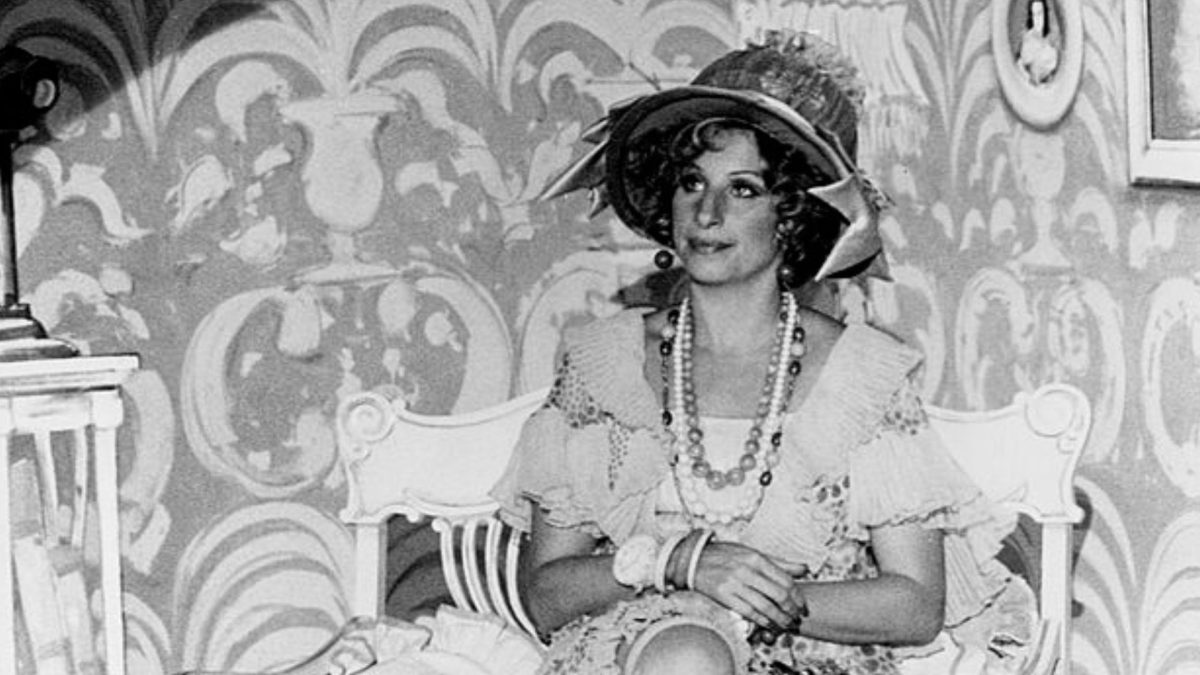‘Funny Girl’ and Barbra Streisand’s insatiable Jewish hunger
Photo of Barbara Streisand from a 1975 television special Funny Girl to funny Lady. The special was to promote the film Funny Lady. (Public Domain)
Published April 20, 2021
(Originally published by Alma)
When Barbra-Streisand-as-Fanny-Brice enters the scene of her deflowerment in Funny Girl, she can’t keep her clothes on. Compelled by the throbbing power of vermillion walls, plush curtains, suggestive female statues, crystal fixtures, and an all-too-inviting divan, her wrap drops to the floor. As Omar Sharif, playing Nicky Arnstein, kneels to retrieve the purple, puffy, duvet-cover-like fabric, Streisand’s body quivers in delight. He’s below her, and she likes it.
After banter underscored by lush strings and suggestive clarinet, their pre-coital number begins, its message simple: “You are woman, I am man,” warbles Nick. “Let’s kiss.” Though mired in outdated notions of seduction and consent, this number positions Barbra Streisand as a sex object — a revolutionary act in 1968, when the film debuted, given her Ashkenazi Jewish persona and look. At the time Gloria Steinem hailed Streisand’s casting as changing “the American ideal…forever” by presenting the Jewish body, the Jewess body, as glamorous and desirable.
ADVERTISEMENT

By 25, Streisand had become a superstar, engaged in a scandalous affair with Sharif and tied for the Oscar with stately WASP Katharine Hepburn. “Hello, gorgeous,” Streisand said as she gripped the statuette, quoting herself as Brice. Yet despite the universal acclaim she won for her performance, a current of insult undermined the adulation. Every profile included a literal profile, spotlighting the Semitic nose that earned her the moniker “big beak” in elementary school. Popular wisdom held that she’d achieved success despite her appearance, with a Funny Girl screenwriter commenting that Streisand had improved life for “homely” Jewish girls.
I first saw Funny Girl in 2000, at age 7, in my grandmother’s den. Barbra had long since peaked. Sure, she was an icon then, as she is now, but this transformation came at a cost. As Joseph Litvak traces in his essay “Jew Envy,” Streisand has morphed into a modern-day “kitsch object,” her notoriously controlling and self-obsessed behavior rendering her an “unwitting self-parody of Hollywood vanity, megalomania, [and] middlebrow banality.”
Yet despite this cultural derision, it’s impossible to ignore Streisand’s influence. Her spiritual children — from Ilana Glazer to Judith Light to Rachel Bloom — populate American television. Messy, sexy, and Jewish, these characters embrace their Yiddishkeit, participating in what Daniel Boyarin calls Jewissance: “a powerful sense of being rooted…in a world of memory, intimacy, and connectedness.” It’s this sense of kinship and “connectedness” that keeps me coming back to these comedians’ creations, and back to Barbra.
The pleasure I take in these performers, however, does not cancel out the painful experience of being an American Jewess with an appetite. A woman who wants, but who is afraid to want. Jess Zimmerman articulates this anxiety well in the remarkable essay “Hunger Makes Me,” writing that, “admitting you have an appetite is a source of cavernous fear” for women who seek to appear “both satisfied and satisfiable.” Instead, Zimmerman tries to adhere — as I have — to a precept that governs both her physical and emotional hunger: “Want less, and you will always have enough.”
ADVERTISEMENT
Though Jewesses can hardly claim ownership over a troubled relationship to hunger, a Jewish, female identity does come with special complications. Don’t buy too much; you’ll look like a Jewish American Princess. Don’t eat too much; you’ll get zaftig. Don’t demand too much; you’ll come across as a castrating bitch. These stereotypes coalesce around an overabundance of want: The Jewish American Princess wants material possessions. The zaftig Jewess wants food. The Jewish mother wants emotional supremacy. In fact, even the virulent antisemitic tropes of the last century exhibit this trait. The Nazis and their forebears warned of the Jewess-as-succubus, a diseased, incestuous prostitute characterized by her sexual voraciousness and perverted appetites. Today, the most cutting portrayals often come from Jewish men, who use their disdain for Jewish women to distance themselves from their own culture (I’m looking at you, Philip Roth).
It is not difficult to identify elements of both sexism and antisemitism in Barbra Streisand’s troubled reputation, though her own behavior hasn’t helped. Too hungry for success, too nakedly ambitious, Streisand’s become a stereotype herself, that of the demanding, Jewish diva — a trap into which wannabe-Barbra-heir Lea Michele recently and irrevocably fell.
Yet in returning to Funny Girl, the story that gave Streisand her start, it is possible to uncover an alternative narrative of female Jewish hunger. While Barbra and the fictive Fanny Brice are often conflated, here they diverge. Whether she longs for recognition that “I’m the Greatest Star” or lusts after the gorgeous Nicky Arnstein, Funny Girl never mocks Fanny for wanting or implies that she is wrong to do so. Instead, more fairytale than biopic, the film creates a reality in which a Jewess with bottomless hunger gets exactly what she desires. As she rises from humble beginnings in Brooklyn to a star slot in the Ziegfeld Follies, a glamorous marriage to the man of her dreams, and eventually a successful career as a nationally known comedian, Fanny never stops seeking out what she wants… nor does she ever stop wanting more.
Streisand’s role as the generative force behind this Jewish American fairytale cannot be overstated. As fashion bloggers Tom+Lorenzo observe, the film contains internal tensions between its musical biopic form and the star that it showcases. The narrative depends on Fanny not being “pretty / Like a Miss Atlantic City.” One of its central conflicts, on the page, is Fanny’s battle with her own self-doubt. Yet according to Tom+Lorenzo’s reading, Streisand “simply refuse[s] to play this character as anything less than brimming with self-confidence.” Armed with anachronistic winged eyeliner, a pale lip, manicured nails, and a series of fashionable costumes — all of which she fought for, at odds with acclaimed costume designer Irene Sharaff and director William Wyler — Streisand presents her character as glamorous even when the script says otherwise.
What results is far more compelling and profound than Funny Girl as originally written. Rather than experiencing the tremendously dispiriting spectacle of a young and frankly gorgeous Streisand pretending to hate herself, modern viewers instead get to watch a voracious, ambitious woman grow into her own appetites. Physically and mentally resilient — she shakes off both male insults and rollerskate crashes — Fanny quickly proves her talent, replacing a tall blonde in an evening gown to sing the romantic “I’d Rather Be Blue (Thinking of You),” her raw charisma overcoming the fact that she wears a hideous drop-waist dress, a bunch of grapes in her hair, and the aforementioned rollerskates.
With those rollerskates still securely strapped, Fanny meets her second great desire: Nicky Arnstein. Appearing like a knight in shining ruffled shirt, Nick is so desirable that he literally lubricates Fanny’s movements, her rollerskates bringing the two together in one smooth, continuous glide. Fanny’s obsession with Nick’s beauty is showcased throughout the movie, but it never feels like that of an ugly woman who can’t believe her luck. Instead, as played by Barbra, Fanny can’t help but revel in the fact that this man — her man — is. Just. So. Hot.
Sharif’s much-derided portrayal of Nick (Roger Ebert complained that he’d never seen “a more wooden male performance in a musical”) makes sense in the context of Fanny’s desire. His strange passivity serves to underline his partner’s agency, furnishing Fanny with an object of desire often expressed by long, wordless shots during which she simply stares at his beautiful image. Doing so reverses the dynamic that characterizes the theatrical side of Fanny’s life, in which she is the object of an audience’s hungry gaze. But this is, after all, a movie, and so as Fanny watches Nicky, its viewers watch her. Or perhaps we watch Barbra Streisand. Many of these shots take place in profile, framing a contour that had become familiar in 1968 and unmistakable by 2020, featuring Barbra’s nose in place of pride.
Freud associates the nose with female genitalia, while other nasal theorists associate this protuberance with the phallus. In these scenes with Nick, perhaps Barbra’s nose replaces a sex organ, its unmistakable shape signaling her physical desire. Psychosexual metaphors aside, noses often happen to be objectively funny, and despite lack of grounding in truth, noses “with deviation” like Streisand’s remain associated with Judaism. Meanwhile, unlike Streisand, who refused at 18 to have her nose fixed, the real-life Fanny Brice actually did have her nose “bobbed” when she was mid-career. Thus in these profile shots, Streisand brings it all together: comedy, Judaism, desire, and her creation of a Jewish fairytale that differs significantly from real life.
In fact, though Funny Girl centers around a fictional depiction of an actual woman, it remains unclear whether the film elucidates more about Brice or Streisand. So forceful was the young star on set that director Wyler quipped, “It wasn’t too hard to work with her considering that it was the first movie she ever directed.” In Fanny’s story, Barbra saw an opportunity — not just to ensure her own stardom, but to create a fairytale for Jewish girls like me, homely or not, who needed it. It is not Fanny Brice, but Barbra-as-Fanny-Brice, whom I watched and wanted to be when I was 7 (and 27). It is Barbra’s hunger that animates the film, and her confidence in her own appetites that makes her portrayal of Fanny so original and alive.
That’s why I find it so appropriate for Funny Girl to end as it does: with Fanny-Barbra alone onstage in a plain black gown, singing the ballad “My Man.” As the song continues, the lights dim. Streisand’s body fades until only her glowing face, neck, and hands are visible, floating in a sea of darkness. With her sleek updo, modern makeup, and lacquered nails, the woman on screen is unmistakably Barbra; she has consumed Fanny Brice. As she belts, “Oh my man, I love him so / He’ll never know,” her pale skin sucks up every ray of light and shred of attention, her boundless hunger clear for all to see as the camera fades to black.
















